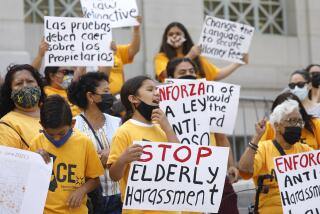Council extends anti-graffiti measure
Opening a new front in the cityâs efforts to reduce tagging, the Los Angeles City Council on Tuesday approved an ordinance requiring that all new homes include a finish that is resistant to spray paint unless the owners promise to remove any graffiti themselves.
The measure, which was unanimously approved, extends a provision in the Los Angeles Municipal Code requiring that new commercial buildings and apartments be coated to a height of 9 feet with an impermeable material, such as ceramic tile, baked enamel or a chemical gloss. Previously, single-family homes and duplexes were exempt.
Officials have tried many approaches to curb the cityâs vexing graffiti problem, including installing high-tech camera systems and making parents liable for civil damages for their childrenâs vandalism.
âThe bottom line is we spend a lot of money on graffiti removal,â said Councilman Bill Rosendahl, who seconded the ordinance when it was introduced by his former colleague, Wendy Greuel, before she was elected city controller. âWouldnât it be great if we didnât have to spend this much money?â
Last year, the Los Angeles Department of Public Works spent $7.1 million to remove 28.2 million square feet of graffiti from 641,000 locations, both public and private, said Paul Racs, who directs the office of community beautification. This is money the city can ill afford to spend in the current economy, Rosendahl said.
Although Councilwoman Jan Perry supported the ordinance, she expressed concern about the burden it places on property owners. Architects, designers and developers have complained that the existing rules add to their costs and limit their choice of construction materials.
City officials acknowledge that not all construction materials are compatible with every finish. Some coatings also cause discoloration to a buildingâs surface and most will wear off with time.
That is why, they said, the measure includes an opt-out provision for owners who sign an agreement to remove any graffiti within seven days of its appearance on their property, or within 72 hours of receiving notification from the Los Angeles Department of Building and Safety.
The Arroyo Seco Neighborhood Council, however, argued that allowing graffiti to stay up for up to seven days will give taggers a ârotating, free canvas.â
âGraffiti is best deterred by having a short life,â the council said in a statement approved in April. âIf taggersâ vandalism is visible the next time they visit, and for a week or more afterward, it encourages them to do more and others to add to it. Seventy-two hours should be the maximum.â
City officials recognize Tuesdayâs ordinance wonât solve the graffiti problem.
The next step, Councilman Tom LaBonge suggested, might be to extend the construction requirements to the governmentâs own buildings and vehicles.
Even so, Racs said after the meeting, âWeâre still going to be taking care of light poles, curbs and stop signs.â
--
More to Read
Sign up for Essential California
The most important California stories and recommendations in your inbox every morning.
You may occasionally receive promotional content from the Los Angeles Times.










